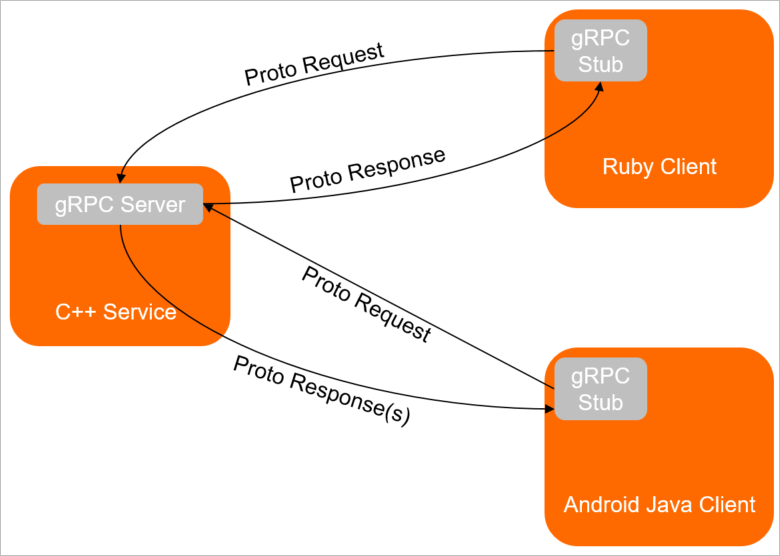Google Remote Procedure Call (gRPC) is developed based on the HTTP/2 protocol and the Protocol Buffers serialization mechanism. gRPC supports various programming languages, multiplexing, header compression, and load balancing. Google gRPC greatly improves the communication efficiency between clients and servers. This topic describes how to use an Ingress controller provided by Container Service for Kubernetes (ACK) to access gRPC services.
Background information
 In gRPC, a client application can directly call a method on a server application on
a different machine the same as the client application calls a local method. This
makes it easier for you to create distributed applications and services. Similar to
other RPC frameworks, gRPC defines a service interface to specify the methods that
can be called remotely and the return types. On the server side, the server implements
the service interface and runs a gRPC server to process client requests.
In gRPC, a client application can directly call a method on a server application on
a different machine the same as the client application calls a local method. This
makes it easier for you to create distributed applications and services. Similar to
other RPC frameworks, gRPC defines a service interface to specify the methods that
can be called remotely and the return types. On the server side, the server implements
the service interface and runs a gRPC server to process client requests.
Prerequisites
- An ACK cluster is created. For more information, see Create an ACK managed cluster.
- The NGINX Ingress controller is installed and its version is 0.22.0 or later. For more information about the versions of the NGINX Ingress controller, see Nginx Ingress Controller.
- A kubectl client is connected to the cluster. For more information, see Connect to ACK clusters by using kubectl.
- gRPCurl is installed. For more information, see gRPCurl.
Examples of gRPC services
option java_multiple_files = true;
option java_package = "io.grpc.examples.helloworld";
option java_outer_classname = "HelloWorldProto";
package helloworld;
// The greeting service definition.
service Greeter {
// Sends a greeting
rpc SayHello (HelloRequest) returns (HelloReply) {}
}
// The request message containing the user's name.
message HelloRequest {
string name = 1;
}
// The response message containing the greetings
message HelloReply {
string message = 1;
}Descriptions
In the NGINX Ingress controller, gRPC services run only on HTTPS ports. The default
HTTPS port for gRPC services is port 443. Therefore, you must configure a domain name
and an SSL certificate for the gRPC service in the production environment. In this
example, the domain name grpc.example.com and a self-signed SSL certificate are used.
In this example, the version of the ACK cluster is 1.20.4-aliyun and the version of the NGINX Ingress controller is v0.44.0.3-8e83e7dc6-aliyun.
If you already have a gRPC service, proceed to Step 3: Create an Ingress.
Step 1: Apply for an SSL certificate
If you want to use an Ingress to distribute requests to the gRPC service, you must configure an SSL certificate for the gRPC service and use the TLS protocol to communicate with the gRPC service.
You can go to SSL Certificates Service console and purchase an SSL certificate. You can also apply for a free SSL certificate on third-party platforms such as Let's Encrypt.
In this example, a self-signed SSL certificate is generated by using OpenSSL.
Step 2: Create resources for the gRPC service
Create a backend service that uses the gRPC protocol. In this example, the registry.cn-hangzhou.aliyuncs.com/acs-sample/grpc-server image is used to create the gRPC service.
Step 3: Create an Ingress
Verify the result
After gRPCurl is installed on your on-premises machine, enter grpcurl <domain name>:443 list to check whether requests are distributed to the backend gRPC service.
In this example, the domain name grpc.example.com and a self-signed certificate are used. Run the following command to check whether
requests are distributed to the backend gRPC service:
grpcurl -insecure -authority grpc.example.com <ip_address>:443 listkubectl get ingress command to query the IP address.
grpc.reflection.v1alpha.ServerReflection
helloworld.Greeter